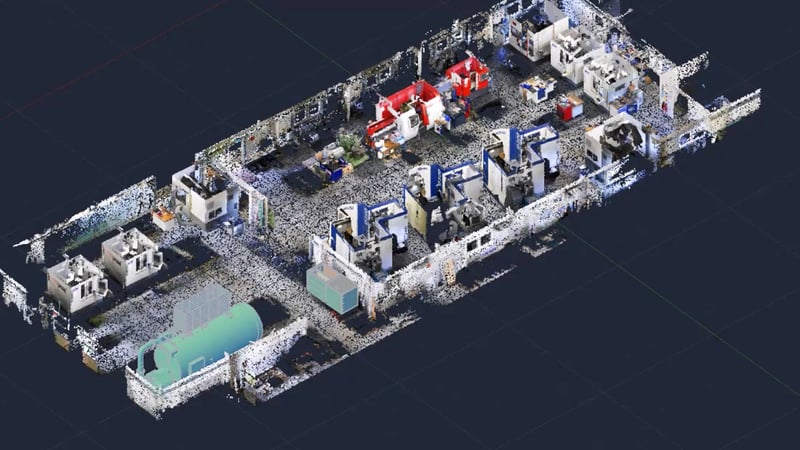Making operational improvements to a manufacturing facility can be carried out for a multitude of reasons – to save time, reduce costs, optimize processes and decision-making, and more. And one of the core activities to achieve these benefits is optimizing their layout and assembly line planning.
The layout of a factory or production facility has a significant impact on day-to-day operations. How far do the raw materials have to travel from the building entrance to the production line? How close is the machinery to the necessary ventilation ducts, lighting, or power outlets? And once the finished product rolls off the line, how long before it reaches the QA bench, then loaded onto transport? All these factors are critical, and a poor layout has real consequences for the bottom line.
Broadly defined, “layout and assembly line planning” is the arrangement of all equipment, machinery, and furnishings within a factory, in accordance with a company’s performance goals. Typically, a Central Factory Layout or Assembly Line Planning Department – or Industrial Engineering Department – would subdivide the task into goal setting, base analysis, concept planning, detailed planning, realization, and ramp-up.
Modern reality capture and visualization technologies like NavVis IVION Enterprise and the NavVis Digital Factory Solution can make the process of layout and assembly planning more effective than ever before. Especially concerning the conceptualization and detailed planning stages.

Why layout and assembly line planning is so important
Factory planners, project managers, and all other teams responsible for layout and assembly changes today need a dynamic, collaborative decision-making process.
The trigger for a change might be the introduction of new products and services, the need for space optimization, or switching up their output in accordance with changing market conditions. In the case of the automotive industry, for example, these events happen at an accelerated pace with car model derivatives.
Other reasons for assembly line changes might be a revision to start of production (SOP) or a product reaching end of production (EOP), but also optimization processes such as line balancing and continuous improvement.
Industrial engineers employed by the company are responsible for the planning and management of these change projects, and they’re typically carried out using external contractors.
Challenges facing factory layout and assembly planning today
One problem for project managers is when they must rely on outdated or incomplete documentation for their planning. The effort required to pull together existing paperwork from various sources can be a tremendous waste of time. It can also cause unnecessary mistakes and change requests, which in turn leads to longer planning cycles and overruns of the project budget. Besides relying on outdated information, the linkage between production data from ERP and the geo-information of the real factory is also often missing.
Another issue occurs when planning is based on a top-down 2D perspective – like a basic floor plan – instead of a feature-rich model. Without the third dimension, it’s easy for important details to get left out, like the height to accommodate overhead installations, or access to power supplies.
Next is the question of how time-consuming and expensive the planning process can be if the onsite as-is status is required. Travel to and from the factory for site and equipment inspections can drag out the process into weeks and months, especially if the factory is in a remote location, or if there are restrictions on travel for health and safety concerns.
Rounding out our series of challenges for the weary factory planner are the data silos that exist between departments and factories, compounded by different 3D data tools, formats, and workflows.
Mark & Measure in NavVis IVION Enterprise levels up the layout and assembly planning workflow
In the scenario outlined in the video above, the factory planner needs to design a new layout regarding lean process improvement.
Here, a specific part of the plant must be remodeled in order to optimize material flow and space utilization, which would allow for an increase in production output for a given time. In NavVis IVION Enterprise, these areas can be identified and marked using a colorized overlay, uniquely named, and grouped into folders for even further clarity using the Mark & Measure tool.
Additionally, the 3D panoramic images in NavVis IVION Enterprise enable factory planners to remotely inspect the current usage and workplace set up in the specified area. Inspecting machine connections to the air, gas, and water supply allows for the planning of future machine requirements, especially when giving external contractors access to the virtual factory.
Once the production steps and workplaces are marked in NavVis IVION Enterprise as documentation of the current layout, the new and existing layouts can be easily compared. The factory planner can see that the new planned layout not only optimizes material flow, but also demonstrates where there is free space that could be used in the future to further increase production by installing an additional line.
When planning is complete, all related information and markups can be shared with colleagues via a web link or exported into an auto-generated PDF that includes the links to each markup, description of the workflow step, and related space usage. It’s really as simple as the click of a button!
Wrapping up
NavVis IVION Enterprise enables all stakeholders to virtually inspect different layouts, gather and link information from various data sources (ERP, MES, e.g.) to assets, visualize processes, and communicate more efficiently with each other. Without having to physically travel, managers and teams can remotely visit sites to understand machines, tools, and even plan entirely new factory layouts. This empowers them to quickly make qualified decisions without the need to be on-site and make substantial savings on time and costs.
But perhaps most importantly for future-proofing your organization, NavVis IVION Enterprise and the entire NavVis Digital Factory Solution enables seamless collaboration with a 3D virtualization of your global manufacturing network. For more information, download our complimentary guide to take the next steps towards your digital factory with NavVis.


